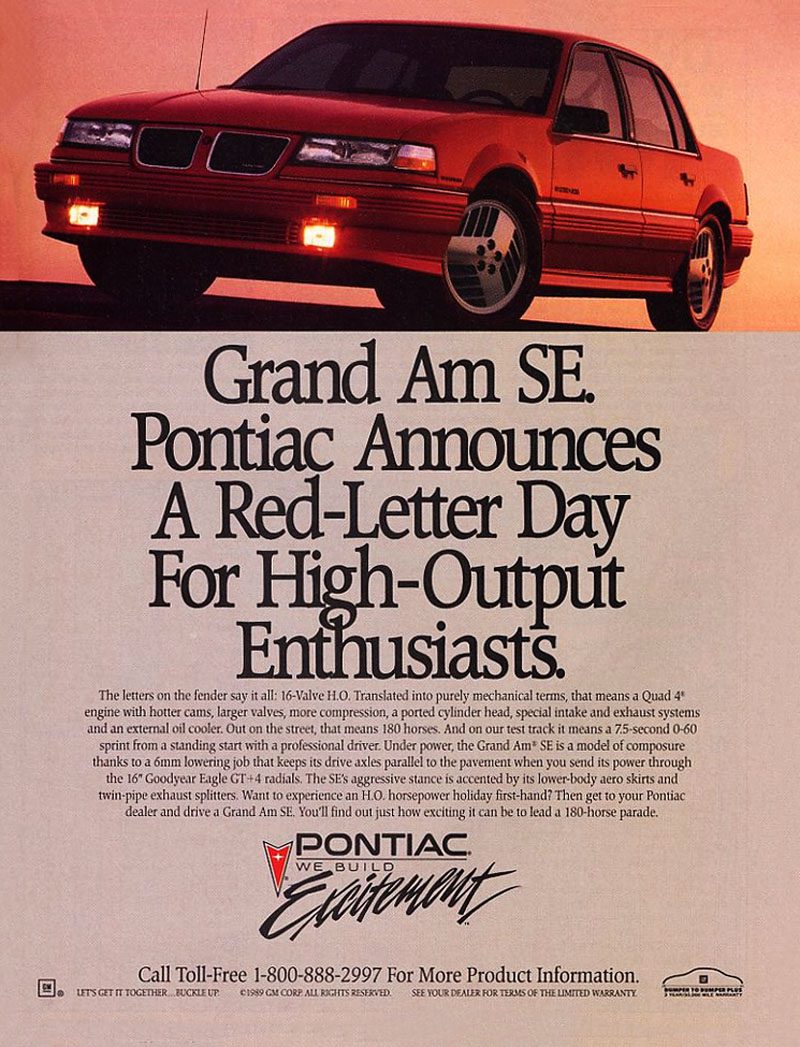Walking the walk, sort of.

It was time for Pontiac to walk the walk. Having claimed since the car’s inception that the Grand Am was infused with the same technology and character as fine European models of similar dimensions, Pontiac was finally able to put its money where its mouth was. Well, sort of.
1989 Pontiac Grand Am
Grand Am SE
New as a compact car for 1985—the name had been applied to a number of Pontiac models prior—the Grand Am had proved to be a hot seller for the brand. Credit the ‘Ams arguably sporty design and affordable lineup, and disregard the car’s cheap interior and mediocre performance. Atop the trim-level mountain was the SE, which until 1989 had been powered by a modestly interesting 3.0-liter V6 produced by Buick. The slow-revving pushrod mill churned out just 125 horsepower, but a reasonable amount of torque, making the car quick enough for stoplight drag-race tomfoolery.
Engines
For a period, a turbocharged 2.0-liter engine was inserted into the Grand Am lineup, but it’s power delivery was peaky, and the motor was famously unreliable.

Quad 4
Enter the “high-output” Quad 4, a fully modern—in concept—4-cylinder engine featuring a 16-valve overhead-cam (OHC) cylinder head, and surprisingly high compression ratio. New for 1989, the LG0 (General Motor’s internal product code) engine produced 180-185 horsepower and was mated exclusively to a 5-speed manual transmission. Folks seeking the convenience of an automatic were downgraded to a 160-horse version of the Quad 4 engine, internally dubbed LD2 by General Motors. Neither the LG0 or LD2 could be had in any Grand Am trim level but the SE. Note that the LG0 required premium gas, which may have limited its appeal. The LD2, however, ran just fine on regular-grade fuel, per Pontiac.
Performance
And with its new engine, the Grand Am finally had—at least on paper—the specs expected of a European-car wannabe. That said, the LG0 engine was something of a disappointment, though not for its performance.
While buff books of the day were reporting impressive 0-60 mph times of around 7.0 seconds for LG0 equipped Grand Ams, reviews of the engine were not especially positive. Though strong, the LG0 was famously loud and coarse sounding, and generally rough overall. This was the antithesis of small German engines of the era, which were famously refined.
Reliability Issues
Making matters worse, the LG0 engine was plagued by reliability problems, including:
- Head-gasket failures
- Timing-chain tensioner issues
- Excessive oil consumption
- Cooling system issues
- Ignition-system failures
This at a time when German cars were famed for their reliability.
Marketing
Offered from 1989 to 1991, the high-output Quad 4 engines largely failed to position the Grand Am as any sort of budget-friendly German-car alternative. Still, with its racy—arguably gaudy—design, and consumer-friendly pricing, the Grand Am continued to sell like hotcakes, even if the technology boasted of in the ad seen here was deeply flawed.
Iron Duke
Most Grand Ams came with GM’s ubiquitous, and generally reliable, Iron Duke 4-cylinder mill. The harmless engine was best known for being reasonable smooth in operation, and also fuel efficient. And while dull, the Iron Duke kept most Grand Am owners pretty happy.
And while the Quad 4 experiment in the Grand Am fell flat, variations of the engine would go on to higher horsepower ratings, and even some racing success in variations of the Oldsmobile Achieva.
Listen to the Car Stuff Podcast
1989 Pontiac Grand Am Pictures
Click below for enlarged images
Consumer Guide Car Stuff Podcast Episode 272: 2025 Consumer Guide Best Buys





